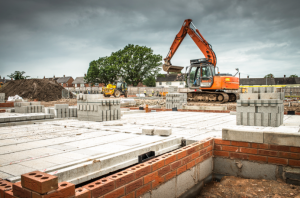Exploring The Sustainability Of New Housing & Nursing Homes

Aging in place is a concept that has gained steam in recent years, particularly as COVID-19 caused people across the world to stay home for the sake of their health… and for their neighbors, too. Many are realizing the value of making their homes safer and more accessible. However, many do not realize the impact that aging in place has on the environment… it’s actually a more Earth-friendly option than moving into a new home that’s seemingly more manageable or an assisted living facility.
In the United States alone, there are circa 17,019,726 vacant homes, according to information from the United States Census Bureau. Millions of houses stand empty, gathering dust and capturing the attention of select few interested home buyers. Why are there so many vacant homes in the U.S.? Quite frankly, the answer isn’t simple. Homes may have lost value over time, extensive repairs may be needed, or a health hazard may have necessitated abandonment of the property. Either way, these homes create pollution that negatively impacts the environment.
Older buildings may have asbestos and lead piping, and leaking appliances and forgotten chemicals offer further health hazards. Plus, a lack of maintenance can lead to mold growth, which comes with its own list of public health issues.
Some types of homes, like split-level houses, remain difficult to sell, meaning they stand at risk of being abandoned after appearing unattractive to buyers. This remains a dark reality as a multitude of new homes and nursing homes are built every day. In fact, according to the U.S. Census Bureau and the U.S. Department of Housing and Urban Development, the number of building permits has risen in the last year. Let’s take a moment to analyze the environmental risks that come with new construction.
New Residential Construction & Environmental Impact
You know that joke about the “new car smell”? There’s just something about that new home smell, isn’t there? And the way the sun seeps through those beautiful new windows… Let’s be honest. New housing is an attractive incentive. However, construction leaves a greater environmental impact than most realize.
Near Leaf Home Safety Solutions’ corporate office in Northeast Ohio is one of the oldest archaeological sites in North America, dating to around 13,000 years of age. What is so magnificent about this site is not only the tools and charcoal-filled pits that showcase early human activity in the New World, but also the post holes that show that a seasonal home was once erected there. Despite thousands of years of change, evidence of human dwellings remain.
That, of course, was eons before the incorporation of modern building material. Today, our building processes leave a much more shocking environmental impact. In fact, the carbon footprint left behind by the construction industry is hard to ignore.

GreenSpec, a U.K.-based group striving to spearhead sustainability initiatives in the construction industry, published an eye-opening collective of research on just how harmful concrete production is. Cement production alone contributes to circa 5 percent of the worldwide total of CO2 emissions. For some perspective, the transportation sector accounts for around 14 to 15 percent of worldwide emissions. Air travel accounts for circa 3 percent of these global emissions. How is cement production so destructive? Perhaps it is less about its destructive manufacturing process and more about the sheer quantity of yearly cement production that causes such a drastic environmental impact. It’s a necessary evil in the construction industry, providing foundations, walkways, and more.
Of course, construction itself is a process that leaves a huge environmental impact. According to Environmental Pollution Centers, construction impacts a few aspects of our environment in particular:
-
-
-
- Airborne contaminants spread via wind
- Water runoff may contain paints, glues, and other toxins
- Soil will inevitably capture construction contaminants
-
-
Noise pollution is another matter altogether, and a matter that neighbors near construction sites vehemently lament. Of course, all of these issues can be negated into an existing home… but old homes often require repairs, sometimes as huge as foundation repair or replacement.
So, the alternative to aging in place or moving into a more manageable home is moving into an assisted living facility… right? That comes with its own set of challenges.
Nursing Homes, Assisted Living Homes, And Quality Of Life
Quality. This is a word that’s deeply resonant, no matter who you are or where you come from. We crave a quality life, we want to utilize quality products. We long for opportunities that help us enhance the quality of day-to-day living, but some environments inevitably present hurdles.
One of the major concerns over life in nursing homes is one that most people would not even consider: air quality. Our sister brand LeafFilter spotlighted Legionnaire’s Disease on their blog, explaining that the sickness was first discovered due to bacteria thriving in moist airways at the American Legion Convention in Philadelphia back in 1976. However, this is not the only bacteria that could impact indoor air quality (IAQ).
According to a 2021 publication in the periodical Science of The Total Environment, IAQ in nursing homes is seldom monitored and oftentimes lacking. This can lead to negative health impacts in older adults, many of whom move into long-term care facilities due largely to health concerns. Air pollution in nursing homes is, believe it or not, a common problem. Do a Google search if you’re brave enough… but the years of evidence of poor and polluted air in shared living spaces is plain to see.

Of course, nursing homes impact another aspect of health, and this one is often at the forefront of the aging in place vs assisted living debate: mental health. Studies prove that the adverse risks of mental health increase as humans age. AARP found that 3 out of every 4 adults over 50 would prefer to stay in their own homes rather than living in a group home… although many fear that such a fate is inevitable.
This, of course, takes a mental toll on a person. There’s nothing worse than feeling old, especially since research suggests that feeling young by maintaining a youthful mental state may actually be linked to longevity. And the price of nursing homes inevitably takes a toll on family members who step up to assist with the sky-high residency costs.
Living At Home & Living GREEN
So you have a home, and it’s one you’ve lived in for quite a bit of time. It’s clearly more sustainable to modify your home to meet your needs than to pursue a new construction that’s smaller or contains fewer stairs. Of course, we’ve also learned that staying in one’s home rather than living in a nursing home has its benefits, too. So how can we live an earth-friendly lifestyle without totally disrupting our lifestyle?
1. Invest in durable, long-lasting materials.
It may seem silly when you think about it, but many products we use are meant to be replaced in just a few years. You’ve probably heard someone lament that “things just aren’t made like they used to be,” and this is largely true. Production has changed. The economy has changed. In actuality, human culture has changed with each new generation of thinkers and doers. However, there are many long-lasting products like fade-proof siding and composite deck materials that lessen your investment in the cycle of manufacturing, transportation, and pollution.

2. Reduce, reuse, and recycle.
It’s an age-old adage that remains in use today: the three R’s. Reduce your consumption, reuse and upcycle what you can, and recycle goods that can be remade into other products. It’s an easy and obvious way to reduce your carbon footprint and to help reduce the number of goods that end up in landfills. Did you know that more than half of the aluminum in the U.S. is recycled? It’s easy to do, and many places will even pay you for scrap.
3. Put your health (and diet) first.
While we’re talking about aging in place and the health benefits it brings, it’s also worth mentioning the power of quality foods. Fruits and veggies don’t need plastic packaging to keep them fresh, and things like apple cores can be composted to prevent landfill contribution. Of course, the benefit of consuming vitamins and minerals speaks for itself. If you choose to grow your own food, this has its own benefits as well – in addition to cutting out a trip to the grocery store and providing easy access to delicious foods, gardens lend beauty to your yard as well.
Whether you are exploring aging in place for yourself or for a family member, you’ll find that it has endless benefits, including the opportunity to live a more sustainable and healthy lifestyle in the home you love. Want to learn more about aging in place? Let the Certified Aging in Place Specialists at Leaf Home Safety Solutions provide a free estimate and some lifestyle-enhancement suggestions to get you started on your in-home journey.


